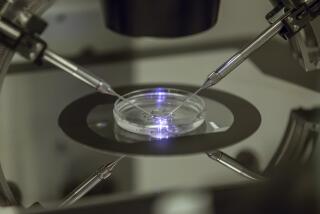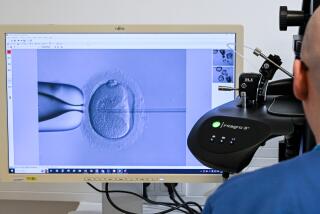Experiments with embryos suggest ways to make 3-parent IVF safer for babies
- Share via
Nearly 800 children are born in the U.S. each year with genetic diseases caused by mutations in a type of DNA inherited directly from their mothers. Scientists are working to prevent these diseases by helping couples have babies with DNA from three parents instead of the usual two.
A new study identifies some of the reasons why this fledgling technique might go awry — and suggests ways for fertility specialists to minimize the risk.
The diseases in question stem from problems in what’s called mitochondrial DNA. This is a collection of 37 genes that control the structures that provide energy to cells. Certain errors in these genes can lead to diseases like Leigh syndrome, a severe neurological disorder that is typically fatal in early childhood, or a condition known as MELAS that causes stroke-like episodes, leading to brain damage.
Women who carry such mutations would prefer not to pass them on to their children. Instead, they can get mitochondrial DNA from a healthy donor and combine it with their own nuclear DNA, the thousands of genes that influence traits like height and eye color.
That’s the idea behind three-parent IVF. Using this technique, couples obtain eggs from a healthy donor, remove the nuclear DNA and replace it with nuclear DNA from the would-be mother. This combination egg is then fertilized by sperm in a dish, incubated for a few days in the lab and then transferred into the would-be mother’s uterus — just as with regular in vitro fertilization.
The result is a child with three genetic “parents.” The first — and so far only — baby known to be conceived this way was born this year to a woman who had lost two other children to Leigh syndrome.
Three-parent IVF has not been approved for use in the United States, though the National Academies of Sciences, Engineering and Medicine has endorsed its use as long as certain ethical conditions are met.
In the United Kingdom, scientists advising the Human Fertilisation and Embryology Authority offered fresh support for the technology on Wednesday. If the HFEA gives final approval, the U.K.’s first three-parent babies could be born next year.
However, one potential problem with this technique is that when specialists transfer a woman’s nuclear DNA into a donor egg, a small amount of her faulty mitochondrial DNA may come along for the ride. A team of scientists overseen by Shoukhrat Mitalipov of the Oregon Health & Science University wanted to see just how much risk this presented for couples.
So they collected eggs from four women who had children with Leigh syndrome and from one women whose child had MELAS. They also retrieved eggs from 11 women who did not have any harmful mutations in their mitochondrial DNA.
The scientists removed the nuclear DNA from dozens of eggs from healthy donors. In 13 of those eggs, they inserted nuclear DNA from mothers of children with mitochondrial diseases. In an additional 36 eggs, they used nuclear DNA from one of the healthy donors; these eggs served as controls.
In tests, both groups of eggs had similar fertilization rates. Overall, about 75% of the fertilized eggs developed to the blastocyst stage, about five days into embryonic development, according to a study published Wednesday in the journal Nature.
A total of 22 fertilized eggs were examined to see how much of their mitochondrial DNA came from women with disease mutations and how much came from the healthy donors. In all 22 cases, more than 99% was from the donors, the team reported.
The researchers also took 15 embryos and converted them into embryonic stem cells. All of the embryos were made with “control” eggs that combined mitochondrial DNA from one healthy donor with the nuclear DNA of another healthy donor. In two of these cell lines, the transplanted nuclear DNA brought with it mitochondrial DNA that wound up overtaking the mitochondrial DNA that was native to the egg, the researchers found.
If this had been a situation involving a mother with faulty mitochondrial DNA and the embryo had grown into a baby, the results might have been disastrous.
So the study authors analyzed patterns among those 15 stem cell lines and identified certain combinations that seemed to benefit the hitchhiking mitochondrial DNA. To get around this problem, they recommended that fertility specialists who perform three-parent IVF match their patients with egg donors who are not just mutation-free but also “compatible,” they wrote.
Such matches “should be possible,” Eric Shoubridge wrote in a commentary that accompanied the study. Shoubridge studies the molecular genetics of mitochondrial diseases at McGill University in Montreal.
Dr. Dusko Ilic, a stem cell researcher at King’s College London, said the study’s findings were “extremely valuable.” By carefully choosing an egg donor on the basis of her mitochondrial DNA, doctors can minimize the risk to patients seeking healthy babies.
“I hope that the teams working on mitochondrial replacement therapies will take this finding on board and implement the screening … in clinical practice,” he said.
Follow me on Twitter @LATkarenkaplan and “like” Los Angeles Times Science & Health on Facebook.
MORE IN SCIENCE
Pluto’s heavy ‘heart’ may have led to depression. Seriously
For high school football players, just a season of play brings brain changes
For a long life, consider picking up a tennis racket







